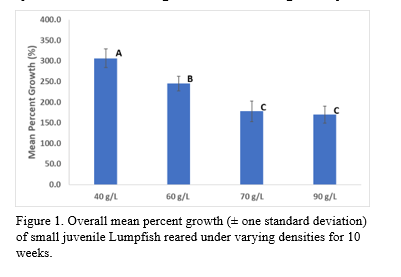NUTRITION AND DENSITY DEPENDENCE AS PROXIES FOR MANIPULATING JUVENILE LUMPFISH Cyclopterus lumpus GROWTH
Lumpfish are of interest to the aquaculture industry because of their usefulness as biological controls for sea lice infestations in salmonid ocean farms. Despite millions of Lumpfish produced each year for this purpose, Lumpfish rearing protocols can be improved by understanding the nutritional needs of and density dependent effects on juvenile fish growth. During 2020-21, a series of experiments evaluating the effects of nutrition and stocking density on the growth, survival, and aggression of juvenile Lumpfish were conducted at the University of New Hampshire’s Coastal Marine Laboratory.
The effects of varying protein (50, 55 %) and lipid concentrations (10, 15, 20 %), as well as plant versus fish meal-based protein sources, on the growth, survival, and aggression of juvenile Lumpfish were evaluated using six experimental diets and two commercial diets. In general, varying protein and lipid concentrations did not negatively affect growth, survival, or fish aggression of juvenile Lumpfish; overall mean percent growth ranged from 633 to 781 %. The use of plant-based protein (and a diet formulated for salmonids), however, suppressed juvenile Lumpfish growth; overall mean percent growth was only 394 %.
Juvenile Lumpfish are aggressive and will bite each other’s fins resulting in severe caudal damage and ultimately death. To determine if this behavior is ontogenetic and density dependent, fish growth, survival, and aggression of two different fish sizes (2 g and 13 g) at four different constant rearing densities (40, 60, 70, and 90 g/L) were measured. For both size classes of Lumpfish, stocking density was negatively correlated with fish growth, but stocking density did not affect either fish survival or fish aggression. Overall mean percent growth of small juveniles ranged from 167 to 307 % (Figure 1), and from 286 to 471 % for large juveniles.
Lumpfish hatchery managers can use this information to manipulate lumpfish growth rates to better match hatchery production to salmonid farms’ cleanerfish needs.
